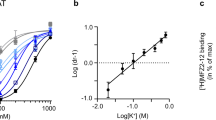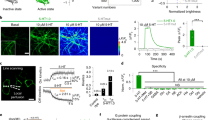Abstract
Serotonin transporters (SERTs) are targets for drugs such as Prozac that increase serotonin (5HT) levels by blocking 5HT reuptake. Although SERTs saturate in the micromolar range, synaptic 5HT may exceed 1 mM. To examine SERT's response to high 5HT concentrations, we expressed Drosophila SERT (dSERT) in Xenopus oocytes and found that transport continued to increase with concentration up to 0.3 mM 5HT. As 5HT is a monovalent cation, its entry through an ion channel in SERT might explain uptake at high concentrations. We therefore investigated dSERT using traditional ion channel methods, including mole-fraction experiments under voltage clamp. We propose that SERTs may function as 5HT-permeable channels, and that this mechanism may be important for clearance of the neurotransmitter at high concentrations.
This is a preview of subscription content, access via your institution
Access options
Subscribe to this journal
Receive 12 print issues and online access
$209.00 per year
only $17.42 per issue
Buy this article
- Purchase on Springer Link
- Instant access to full article PDF
Prices may be subject to local taxes which are calculated during checkout






Similar content being viewed by others
References
Guan, X. M. & McBride, W. J. Fluoxetine increases the extracellular levels of serotonin in the nucleus accumbens. Brain Res. Bull. 21, 43–46 (1998).
Fuller, R. W., Hemrick-Luecke, S. K. & Snoddy, H. D. Effects of duloxetine, an antidepressant drug candidate, on concentrations of monoamines and their metabolites in rats and mice. J. Pharmacol. Exp. Ther. 269, 132– 136 (1994).
Barker, E. L. & Blakely, R. D. in Psychopharmacology: The Fourth Generation of Progress (eds. Bloom, F. E. & Kupfer, D. J.) 321–333 (Raven, New York, 1995).
Eccles, J. C. & Jaeger, J. C. The relationship between the mode of operation and the dimensions of the junctional regions at synapses and motor end-organs. Proc. R. Soc. Biol. Sci. 148, 38–56 (1958).
Clements, J. D., Lester, R. A., Tong, G., Jahr, C. E. & Westbrook, G. L. The time course of glutamate in the synaptic cleft. Science 258, 1498–1501 (1992).
Duncan, G. E. et al. Autoradiographic characterization of imipramine and citalopram binding in rat and human brain: species differences and relationships to serotonin innervation patterns. Brain Res. 591 181 –197 (1992).
Bunin, M. A. & Wightman, R. M. Quantitative evaluation of 5-hydroxytryptamine (serotonin) neuronal release and uptake: an investigation of extrasynaptic transmission. J. Neurosci. 18, 4854– 4860 (1998).
Mager, S. et al. Conducting states of a mammalian serotonin transporter. Neuron 12, 845–859 ( 1994).
Corey, J. L., Quick, M. W., Davidson, N., Lester, H. A. & Guastella, J. A cocaine-sensitive Drosophila serotonin transporter: Cloning, expression, and electrophysiological characterization. Proc. Natl. Acad. Sci. USA 91, 1188–1192 (1994).
Ramamoorthy, S. et al. Antidepressant- and cocaine-sensitive human serotonin transporter: molecular cloning, expression, and chromosomal localization. Proc. Natl. Acad. Sci. USA 90, 2542–2546 (1993).
Blakely, R. D. et al. Cloning and expression of a functional serotonin transporter from rat brain. Nature 354, 66– 69 (1991).
Bruns, D., Engert, F. & Lux, H.-D. A fast activating presynaptic reuptake current during serotonergic transmission in identified neurons of Hirudo. Neuron 10, 559–572 ( 1993).
Galli, A., Petersen, C. I., deBlaquiere, M., Blakely, R. D. & DeFelice, L. J. Drosophila serotonin transporters have voltage-dependent uptake coupled to a serotonin-gated ion channel. J. Neurosci. 17, 3401– 3411 (1997).
Humphreys, C. J., Levin, J. & Rudnick, G. Antidepressant binding to the porcine and human platelet serotonin transporters. Mol. Pharmacol. 33, 657–663 (1988).
Lin, F., Lester, H. A. & Mager, S. Single-channel currents produced by the serotonin transporter, and analysis of a mutation affecting ion permeation. Biophys. J . 71, 3126–3135 ( 1996).
Sonders, M. & Amara, S. G. Channels in transporters. Curr. Opin. Neurobiol. 6, 294–302 (1996).
DeFelice, L. J. & Blakely, R. D. Pore models for transporters? Biophys. J. 70, 579– 580 (1996).
Sonders, M. S., Zhu, S.-J., Zahniser, N. R., Kavanaugh, M. P. & Amara, S. G. Multiple ionic conductances of the human dopamine transporter: the actions of dopamine and psychostimulants. J. Neurosci. 17, 960–974 (1997).
Cammack, J. N. & Schwartz, E. A. Channel behavior in a γ-aminobutyrate transporter. Proc. Natl. Acad. Sci. USA 93, 723–727 ( 1996).
Galli, A., Blakely, R. D. & DeFelice, L. J. Norepinephrine transporters have channel modes of conduction. Proc. Natl. Acad. Sci. USA 93, 8671–8676 (1996).
Hagiwara, S. & Takahashi, K. The anomalous rectification and cation selectivity of the membrane of a starfish egg cell. J. Membr. Biol. 18, 61–80 ( 1974).
Neher, E., Sandblom, J. & Eisenman, G. Ion selectivity, saturation, and block in gramicidin A channels. J. Membr. Biol. 40, 97– 116 (1978).
Hess, P. & Tsien, R. W. Mechanism of ion permeation through calcium channels. Nature 309, 453– 456 (1984).
Almers, W., McCleskey, E. W. & Palade, P. T. A non-selective cation conductance in frog muscle membrane blocked by micromolar external calcium ions. J. Physiol. (Lond.) 353, 565–583 ( 1984).
Almers, W. & McCleskey, E. W. Non-selective conductance in calcium channels of frog muscle: calcium selectivity in a single-file pore. J. Physiol. (Lond.) 353, 585– 608 (1984).
Hille, B. Ionic Channels of Excitable Membranes 2nd edn. 362– 389 (Sinauer, Sunderland, Massachusetts, 1992).
Aidley, D. J. & Stanfield, P. R. Ion channels 121 –160 (Cambridge Univ. Press, Cambridge, UK, 1996).
Demchyshyn, L. L. et al. Cloning, expression, and localization of a chloride-facilitated, cocaine-sensitive serotonin transporter from Drosophila melanogaster. Proc. Natl. Acad. Sci. USA 91, 5158– 5162 (1994).
Trimmer, J. S. et al. Primary structure and functional expression of a mammalian skeletal muscle sodium channel. Neuron 3, 33–49 (1989).
Cao, Y., Mager, S. & Lester, H. A. H+ permeation and pH regulation at a mammalian serotonin transporter. J. Neurosci. 17, 2257–2266 (1997).
Keyes, S. R. & Rudnick, G. Coupling of transmembrane proton gradients to platelet serotonin transport. J. Biol. Chem. 257, 1172–1176 (1982).
Cool, D. R., Leibach, F. H. & Ganapathy, V. Modulation of serotonin uptake kinetics by ions and ion gradients in human placental brush-border membrane vesicles. Biochemistry 29 1818–1822 (1990).
Nelson, P. J. & Rudnick, G. Coupling between platelet 5-hydroxytryptamine and potassium transport. J. Biol. Chem. 254, 10084–10089 (1979).
Su, A., Mager, S., Mayo, S. L. & Lester, H. A. A multi-substrate single-file model for ion-coupled transporters. Biophys. J. 70, 762–777 (1996).
Gu, H., Wall, S. C. & Rudnick, G. Stable expression of biogenic amine transporters reveals differences in inhibitor sensitivity, kinetics, and ion dependence. J. Biol. Chem. 269, 7124–7130 (1994).
Hodgkin, A. L. & Keynes, R. D. The potassium permeability of a giant nerve fibre. J. Physiol. (Lond.) 128, 61–88 (1955).
Galli, A., Blakely, R. D. & DeFelice, L. J. Patch-clamp and amperometric recordings from norepinephrine transporters: channel activity and voltage-dependent uptake. ( 1999).
Acknowledgements
A NARSAD Distinguished Investigator Award to L.J.D. and NINDS Grant NS-34075 and NIDA Grant DA-07390 supported this work. We wish to thank Gary Rudnick, Randy Blakely and Christoph Fahlke for discussion, Jeff Balser for the μ1 clone, Hyeon-Gyu Shin for assistance with μ1 characterization and Dawn Borromeo for help in harvesting oocytes, preparing solutions and other technical assistance.
Author information
Authors and Affiliations
Corresponding author
Rights and permissions
About this article
Cite this article
Petersen, C., DeFelice, L. Ionic interactions in the Drosophila serotonin transporter identify it as a serotonin channel. Nat Neurosci 2, 605–610 (1999). https://doi.org/10.1038/10158
Received:
Accepted:
Issue Date:
DOI: https://doi.org/10.1038/10158
This article is cited by
-
Chloride requirement for monoamine transporters
Pflügers Archiv - European Journal of Physiology (2016)
-
Serotonin Transporters – Structure and Function
Journal of Membrane Biology (2006)
-
The significance of molecular slips in transport systems
Nature Reviews Molecular Cell Biology (2002)



